I'm having trouble to make a loop and I have no idea what is going wrong. My data contains list within a list. I have >50 primary list i.e. [[i]]. Each of the [[i]] contains 20 `i`` (=sublist). A subset of my data looks like
>data
[[1]]$`1`
X Y Height_m kt_Result
1 253641.0 2630050 90 560
74 253845.7 2630552 90 270
156 254353.6 2630195 130 0
171 254554.9 2630220 170 390
173 254565.9 2630323 120 304
[[1]]$`2`
X Y Height_m kt_Result
5 253641.0 2630050 50 860
77 253845.7 2630552 20 370
159 254353.6 2630195 190 20
177 254554.9 2630220 140 310
200 254565.9 2630323 100 804
... ...
[[2]]$`1`
X Y Height_m kt_Result
4 253641.0 2630050 10 960
78 253845.7 2630552 20 220
150 254353.6 2630195 330 5
377 254554.9 2630220 670 340
100 254565.9 2630323 220 314
... ...
When I want to plot each of the sublist with different colors in one plot, it doesn't work
#blank plot (dfs is a different data frame with the same data)
plot(dfs[[1]]$kt_Result, dfs[[1]]$Height_m, type='n')
#plot sublist
lapply(1:length(data[[1]]), function(i)
points(data[[1]]$`i`$kt_Result, data[[1]]$`i`$Height_m,
ylim=rev(c(0, max(data[[1]]$`i`$Height_m))),
xlim= c(min(data[[1]]$`i`$kt_Result, na.rm=TRUE),
max(data[[1]]$`i`$kt_Result, na.rm=TRUE)), lwd=2, type='b',col=i))
I get warnings without any plot
There were 50 or more warnings (use warnings() to see the first 50)
> warnings()
Warning messages:
1: In max(data[[1]]$i$Height_m) : no non-missing arguments to max; returning -Inf
2: In min(data[[1]]$i$kt_Result, na.rm = TRUE) :
no non-missing arguments to min; returning Inf
3: In max(data[[1]]$i$kt_Result, na.rm = TRUE) :
no non-missing arguments to max; returning -Inf
... ...
When I plot without any x-/y- limits, it gives no warning or plot, just shows NULL in workspace!
lapply(1:length(data[[1]]), function(i)
points(data[[1]]$`i`$kt_Result, data[[1]]$`i`$Height_m,
lwd=2, type='p',col=i))
[[1]]
NULL
[[2]]
NULL
...
[[20]]
NULL
However, when I plot the data one by one, it works, but this is an impractical way to deal with such a large dataset
plot(dfs[[1]]$kt_Result, dfs[[1]]$Height_m, type='n')
points(data[[1]]$`1`$kt_Result, data[[1]]$`1`$Height_m, col='red')
points(data[[1]]$`2`$kt_Result, data[[1]]$`2`$Height_m, col='green')
... ...
points(data[[1]]$`19`$kt_Result, data[[1]]$`19`$Height_m, col='cyan')
points(data[[1]]$`20`$kt_Result, data[[1]]$`20`$Height_m, col='blue')
Any idea why this simple loop is not working?

